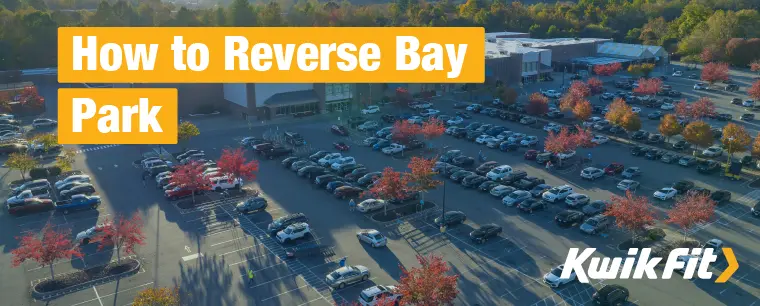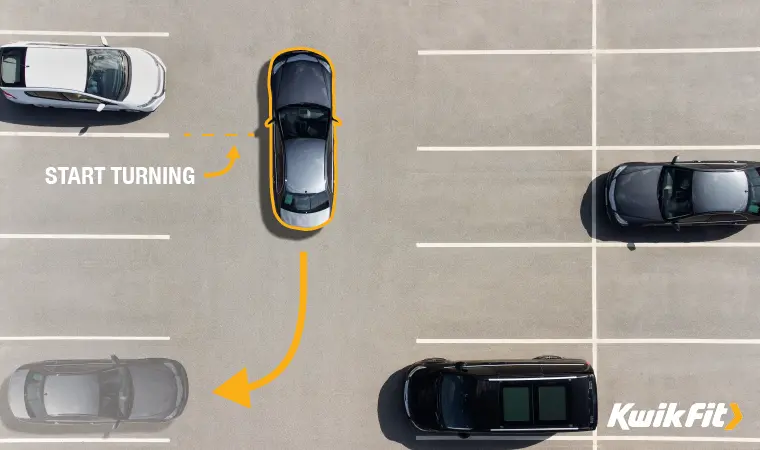How to Reverse Bay Park – A Skill for Life (Not Just Your Driving Test)
Jack Dreyer | Friday 11th August 2023 12:00pm

Manoeuvres are some of the hardest things to master in preparation for passing your driving test, but you don’t technically have to master every manoeuvre. Many people master a few, get confident with a few more, and hope some others don’t get requested on the day of the test. Other manoeuvres still, like reversing around a corner, aren’t even required for tests anymore!
Bay parking is one of the most often-used manoeuvres in the real world: we need it to get into almost any space in a car park, and being able to reliably bay park lets you get safely into or out of a house’s drive.
So what exactly is bay parking, and what’s the difference between forward and reverse parking?
Bay parking is parking with a 90° turn

Like a “bay window” is a window that juts out of a home at 90°, a “bay” parking space is one that’s set at 90° to the road. Almost all modern car parks are made up using 90° bays because it lets you pack more spaces into the same amount of space.
Until recently, however, car park spaces tended to be set at a 45° angle to the road (known as ‘echelon bays’) so that you could get in more easily but, with the invention of power steering, car manoeuvrability became much easier and made the 90° bay possible.
What is forward & reverse bay parking?
The simple distinction between the two types of bay parking are:
Forward Bay Parking: is where you drive forwards into the space and have to reverse back onto the road to get out.
Reverse Bay Parking: is where you reverse into the bay and are able to drive forwards out of the space when you leave.
No doubt there have been heated debates in pubs between driving instructors (off shift, of course) about which one’s most effective — but the truth is that they’re both effective at different times and for different reasons.
Like learning to play an instrument, you don’t learn a scale in order to only play that scale, you learn it so you can use it when you need it. It’s crucial, therefore, to be able to bay park both forwards and backwards.
Pros & cons of different bay parking
Parking forwards makes it easier to get into a space, but means you have to be extra cautious getting out because you’ll be reversing into potentially oncoming traffic. In a supermarket car park, of course, the oncoming cars should be driving quite slowly, but your reduced view (especially when between two other cars) makes things a lot harder.
At the same time, forward bay parking in a supermarket car park makes it much easier to get your shopping in the boot.
Reverse parking is often seen as harder to do, but makes getting out of the space much easier because you have much more visibility! Due to the mechanics of where a car turns from, you can park much more accurately in tight spaces by reversing into them than you otherwise would if you tried to drive forwards into them.
How to reverse bay park

We’ll assume that we’re reverse parking to the left – parking to the right has exactly the same steps but you need to adjust where your reference points are.
- Begin by checking that there’s no oncoming traffic, cyclists, pedestrians, or any other hazard.
- To give yourself enough room, position your car in the middle of the road and select a target bay.
- From the furthest line of the target bay, continue to slowly drive forward three more bay lines.
- Stop when your shoulder is lined up with the third bay line. This alignment is crucial to get an accurate reverse.
- Indicate that you are turning, and check again around your car to ensure there aren’t any new hazards.
- Slowly begin to reverse straight until the second bay line becomes level with your shoulders.
- Then quickly and smoothly turn the wheel left full lock.
- Maintaining complete control of the slow reverse, continue turning while checking your wing mirrors for alignment.
- As you see the lines of the bay become parallel to you, quickly turn the wheels straight, and slowly reverse until you are fully within the space.

Now, the exact turning characteristics and reference points will vary depending on the size & model of car that you’re driving: a long family estate car, for example, may need more room to turn than a hatchback would.
It’s usually a good idea to practise reverse parking both to the left & right in a quiet car park in order to get familiar with your car’s characteristics & build confidence.
Need a tyre check?
Getting into a tight spot’s often easy with practise, but poor tyre condition can easily get you into a tight spot. Be sure to regularly check your car’s tyres – and book into your local Kwik Fit for a free tyre inspection if you’re not sure what to look for.
Any facts, figures and prices shown in our blog articles are correct at time of publication.
Featured Articles
Is it Illegal to Drive With One Headlight?
Saturday 19th July 2025
Wondering if it’s illegal to drive with one headlight? Learn about the safety risks and penalties of illegal blown bulbs and why you should fix them promptly.
Air Con in EVs & Hybrids: Experts Answer Your Questions
Monday 30th June 2025
Does air con drain EV batteries? Can you use the air con while charging an electric car? Find out the answers to these questions & more from Kwik Fit’s experts.
Why Is Your Car Making a Noise? Fixes & Tips
Friday 13th June 2025
When your car starts making unexpected noises, it can certainly be quite disconcerting; it may be nothing to worry about, but here’s what you need to know.









